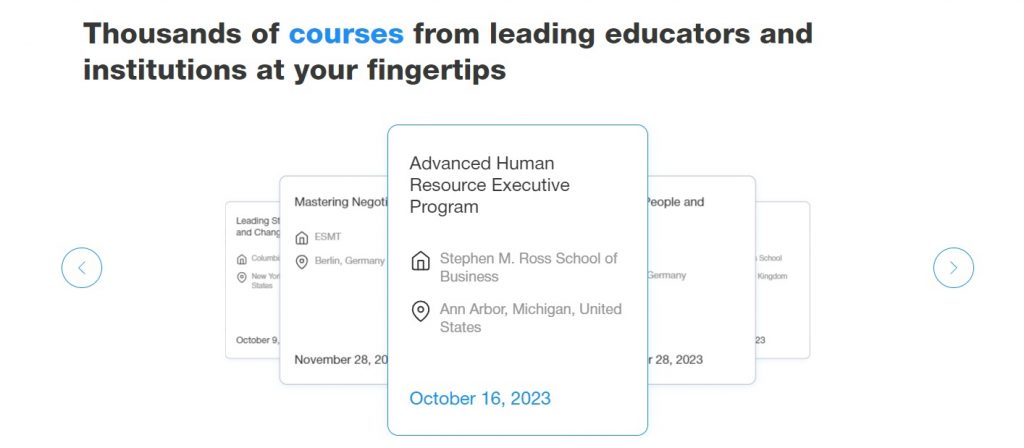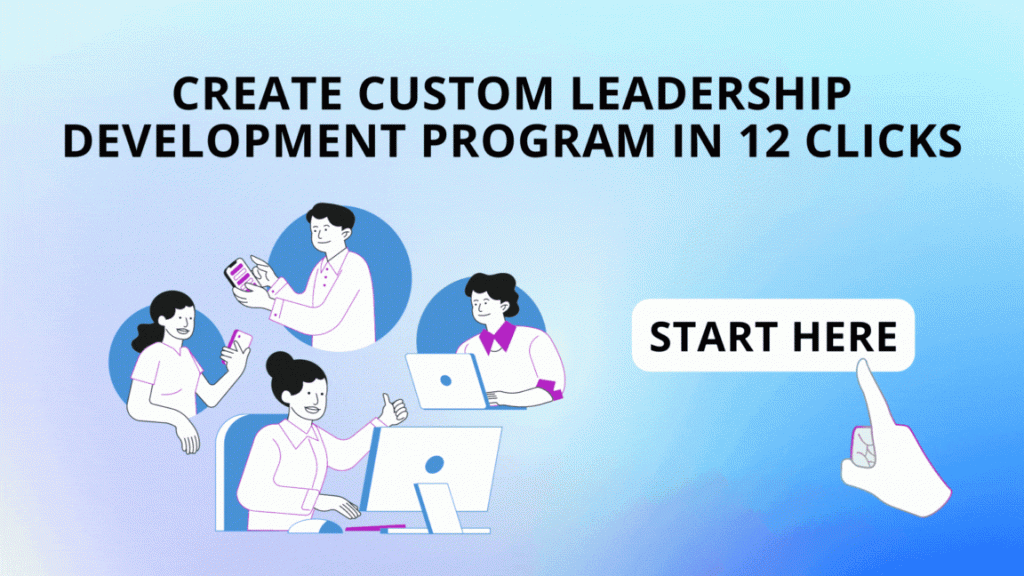4 Steps to Design Training Programs12 min read
Reading Time: 9 minutesReading Time: 9 minutesOnce the leadership training needs have been identified, organizations can design training programs that address those needs. This step involves carefully selecting appropriate training methods and incorporating experiential learning and practical application.
1. Select appropriate training methods

When it comes to selecting appropriate training methods for leadership development, organizations have various options to choose from, including workshops, seminars, online courses, simulations, and more. Each method has its own distinct characteristics and benefits, making them suitable for different situations and learning preferences. Here is a more detailed description of these training methods and the scenarios in which they can be effectively utilized:
Select some of these methods
Seminars
Seminars are formal presentations delivered by subject matter experts. They focus on knowledge transfer and are ideal for skills development, ensuring that theory meets practice and is applicable to specific company’s needs. Seminars include much more than lectures and presentations; they involve case study discussions, business games, simulations, group analysis of company-specific topics etc. They are valuable for introducing new ideas, providing industry insights, and enhancing participants’ understanding of a specific topic. Seminars benefit organizations looking to inspire thought leadership, disseminate information, and create awareness about emerging trends. Looking for an expert to lead the seminar? Tell us about your business goals and expectations and we will find the best learning option for you.
Online Courses
Another method for you to consider is online courses, which provide a structured curriculum, allowing participants to access course materials anytime and anywhere. Offering a broad spectrum of subjects, these courses are especially beneficial for honing specific skills or delving deep into a niche topic. For the ever-busy professional or geographically dispersed teams, the convenience of remote learning is unparalleled. They are the perfect choice for those who lean towards self-directed learning and possess the discipline to steer their own educational journey.
Discover the ideal executive program tailored to your aspirations with our comprehensive selection and booking service. From expert coaching to seamless admission processes, we guide you every step of the way. Dive into a world of premier educational experiences — fill out the form now to embark on your journey.

Blended Learning
The third method to consider is blended learning, which combines multiple training methods, such as a combination of workshops, seminars, and online modules. This approach provides a well-rounded learning experience by incorporating the benefits of various methods. Blended learning allows organizations to design training programs to meet specific learning objectives, maximize engagement, and accommodate diverse learning styles. It combines the advantages of face-to-face interaction, experiential learning, and self-paced online learning.
When selecting the most suitable training method, organizations should consider factors such as the learning objectives, the desired level of interactivity, the complexity of the subject matter, the availability and geographical distribution of participants, and the budgetary constraints. It is essential to align the chosen method with the specific learning preferences and objectives of the participants to ensure effective and targeted development opportunities.
By carefully considering the unique benefits and characteristics of each training method, organizations can design training programs, including leadership development program that meets the specific needs of their leaders.

Incorporate experiential learning and practical application
To enhance the impact of leadership development initiatives, organizations should focus on experiential learning and practical application. This approach allows leaders to apply their newly acquired knowledge and skills in real-world scenarios, fostering a deeper understanding and strengthening their leadership capabilities.
Interactive Learning Experiences
The digital age has provided us with a plethora of tools, and with them, we’re reshaping the realm of education. The rise of interactive learning experiences harnesses these tools, plunging students into multi-sensory worlds where they don’t just learn; they live the lessons. Leading institutions like INSEAD business school and IE University are at the forefront, ushering in this new era with groundbreaking programs and cutting-edge facilities.
INSEAD’s VR Immersive Learning Initiative: Pioneering a transformative change in business education, INSEAD has embarked on a visionary venture. Imagine classrooms without boundaries, where diverse minds connect and collaborate, regardless of geography. Their VR Immersive Learning Initiative aspires precisely to this future. Aimed at revolutionizing management and business education, this project is anchored in the marriage of cultures, ideas, and VR and XR EdTech. The scope is vast, from content creation for degree programs to diving deep into VR analytics and research. This mission, supported by the Abu Dhabi Department of Education and Knowledge, paints an enticing picture of education’s future: immersive, data-driven, cost-effective, and universally accessible.
IE University’s “Liquid Learning” Model: As we glide into a future where boundaries blur between the digital and physical, IE University’s “Liquid Learning” offers a roadmap. It’s a dive into Extended Reality (XR), which envelopes both Virtual Reality (VR) and Augmented Reality (AR). But this isn’t just about technology; it’s about making learning tangible. By partnering with trailblazers like Bodyswaps, Virtualspeech, and Unity, IE University is crafting experiences that transcend traditional classroom confines. And the innovation doesn’t stop there. The incorporation of Oculus Quest 2 VR and AR glasses and the creation of immersive environments, such as the XR Lab, forecast a radical shift in how we view education. Their ambitious target for 2023? Tapping into virtual realms like Roblox and Decentraland, envisioning a world where students from any corner of the globe can attend virtual classes and interact in a shared metaverse.
Wharton’s ARC.platform: Another beacon of innovation in this space is the ARC.platform. This Alternate Reality Courseware gaming engine offers learners an experience like no other. Merging simulations, games, and classical instruction, it plunges students into narratives, allowing them to practice skills and decision-making in a safe, virtual environment. The power of this platform lies in its three-fold objectives: focusing on learning, practice, and thinking. Feedback from students who’ve engaged with ARC is overwhelmingly positive, underscoring its potential to bridge the theory-practice gap and redefine experiential learning.
In a world of technological advances, the horizons of education are expanding. These interactive learning experiences are not just about embracing the new; they’re about crafting a future where learning is not just effective but also deeply engaging and widely accessible.
Experiential Learning
As we navigate the avenues of learning and training, experiential learning stands as a vital pillar. It’s not just about theoretical understanding; it’s about witnessing, experiencing, and learning in real-world contexts. Learning expeditions, as championed by programs worldwide, let talents witness the future in its raw form, outside the confines of a boardroom. These journeys are designed meticulously to immerse learners in hyper-dynamic ecosystems, where they not only gain disruptive and relevant inputs but also bond with their team. The journey’s flow is crafted to help understand challenges, devise a thematic architecture, and act on the learnings within their organizations. This comprehensive approach ensures an enriching experience, from research and design to program management and evaluation.
Another groundbreaking trend in experiential learning is the incorporation of extreme practices in education. In the quest for resilience, decision-making, and self-management, businesses are looking at military-led wilderness training and other challenging scenarios. Programs like Talent War Group’s “Into the Wild – Extreme” are pioneering this. Imagine business leaders, habituated to boardroom conferences, finding themselves in the wild, led by retired military instructors. Such experiences demand rapid decision-making, resilience, and self-awareness, molding leaders for challenging business landscapes. Even elite business schools like Johns Hopkins University Carey Business School are venturing into this, with programs like their leadership development course in Belize’s waterways.
These extreme elements, though niche, reflect the evolving dynamics of management education. They emphasize that in a rapidly changing world, learning isn’t confined to classrooms but extends to varied terrains and scenarios.
2. Design leadership development modules

Designing effective leadership development modules involves practical examples, engaging participants, and addressing specific leadership needs. By drawing inspiration from successful leadership development programs, organizations can gain valuable insights and adopt effective strategies for developing leadership skills.
Customize training to address specific needs
Leadership development is not a one-size-fits-all endeavor. Every organization has its own unique set of leadership development needs, influenced by industry dynamics, organizational culture, strategic objectives, and the specific challenges faced. To ensure maximum effectiveness and impact, it is crucial to design training programs and customize them to address the specific requirements of the organization.
At Coursalytics, we are professionals with extensive experience in creating customized leadership training programs. We have worked with companies from various industries and understand the unique needs and challenges organizations face. By leveraging our expertise and experience, we save valuable time for HRs and CLOs, allowing them to focus on other strategic initiatives. If you seek guidance in leadership development for your organization, we invite you to fill out the form and discuss your leadership goals with our team of experts.
3. Establish KPIs or other success metrics

It is not enough to design training programs, one also need to monitor the training and development process. This is a crucial step in ensuring the effectiveness and ongoing improvement of leadership skills within an organization. By establishing clear and measurable KPIs and regularly evaluating the effectiveness of training initiatives, organizations can track progress, identify areas of improvement, and make necessary adjustments to optimize leadership development programs.
Organizations should establish clear and measurable KPIs that align with their leadership development goals and objectives. These KPIs serve as measurable benchmarks to track progress and evaluate the impact of leadership development initiatives. For example, KPIs may include increased employee engagement levels, improved team performance metrics, enhanced decision-making capabilities, or leadership effectiveness assessments.
Select appropriate program evaluation models
Kirkpatrick’s Four Levels of Evaluation
To assess the overall effectiveness of a learning program, organizations can utilize various evaluation models. For instance, Kirkpatrick’s Four Levels of Evaluation provides a comprehensive framework that assesses training at four levels: reaction, learning, behavior, and results. To apply this model, one should design surveys and assessments to gather participant feedback, conduct post-training evaluations to measure knowledge acquisition and behavioral changes and analyze business outcomes to evaluate the program’s impact.
Phillips’ ROI Methodology
Another evaluation model is Phillips’ ROI Methodology which focuses on measuring the return on investment of training programs by considering the financial impact of the training. To use this model, one should establish clear metrics to track costs and benefits, conduct pre- and post-training assessments to measure improvements in performance and calculate the financial ROI of the training initiative.
Brinkerhoff’s Success Case Method
Finally, there is Brinkerhoff’s Success Case Method which examines the success stories or cases resulting from training interventions to identify and showcase the impact on business outcomes. To apply this model, one should select representative cases, conduct in-depth interviews or surveys with participants, analyze the qualitative and quantitative data collected, and present compelling success stories to stakeholders.
Each evaluation model offers unique insights and benefits, allowing organizations to choose the most suitable approach based on their specific needs and objectives. By implementing action plans tailored to each model, organizations can effectively evaluate the impact of their learning programs and make informed decisions for continuous improvement.
4. Track and evaluate the effectiveness of training initiatives

Regular monitoring and evaluation of training initiatives are critical to assess their impact and identify areas for improvement. As Bruce C. Rudy, Associate Professor of Strategy in the Department of Management at the University of Texas at San Antonio, highlights, “to assess the overall effectiveness of a learning program, it’s often helpful to aggregate individual results at the team or organizational level. This analysis can help you determine organizational level outcomes, such as how employees’ commitment levels or key competencies have changed as a result of the training.”
This part of our guide on how to design training programs involves proactive steps such as gathering participant feedback, conducting assessments, and performing post-training evaluations. Valuable insights can be gained from feedback provided by participants, which helps determine the relevance, effectiveness, and applicability of the training programs. Assessments play a vital role in measuring the acquisition of new skills, knowledge, and behaviors, while post-training evaluations offer a means to gauge the long-term impact of the training on leadership performance. By consistently evaluating and refining leadership development programs based on real-time feedback and evolving organizational needs, organizations can create a culture of continuous growth and development.
Regularly assess and address leadership development needs
The journey of leadership development doesn’t end with the implementation of training programs; it requires a continuous commitment to regularly assess and address leadership development needs. This ongoing process ensures that organizations remain agile, adaptable, and equipped with leaders with the skills and qualities needed to navigate the challenges of a rapidly evolving business landscape.
By periodically evaluating their leadership landscape, organizations can identify emerging trends, skill gaps, and evolving business requirements. This assessment provides valuable insights that inform the development of targeted training initiatives and ensures that leadership development efforts remain relevant and aligned with organizational goals.
Foster continuous improvement and growth in leadership skills
Continuous improvement and growth in leadership skills are crucial for leaders to stay ahead in a competitive environment. Effective leaders understand the value of continuous learning and strive to enhance their abilities, adapt to new challenges, and inspire their teams. By fostering a culture of continuous improvement, organizations create a nurturing environment where leaders are empowered to acquire new knowledge, refine their skills, and embrace innovation.
Empower organizations with effective leadership training
Effective leadership training programs empower organizations by equipping leaders with the necessary tools, knowledge, and skills to drive success. By investing in effective leadership training, organizations unlock the full potential of their leaders, fostering a positive impact on employee engagement, team collaboration, and overall organizational performance. Effective leaders inspire others, drive positive change, and contribute to a thriving organizational culture that attracts and retains top talent.
In conclusion, organizations that recognize the importance of leadership development, embrace continuous improvement and invest in effective leadership training position themselves for long-term success. By regularly assessing and addressing leadership development needs, organizations ensure that their leaders have the skills, competencies, and qualities necessary to navigate complex business landscapes. Embrace the transformative power of leadership development and empower your organization with these four steps to design training programs. Together, let’s embark on a journey of growth, innovation, and leadership excellence.





